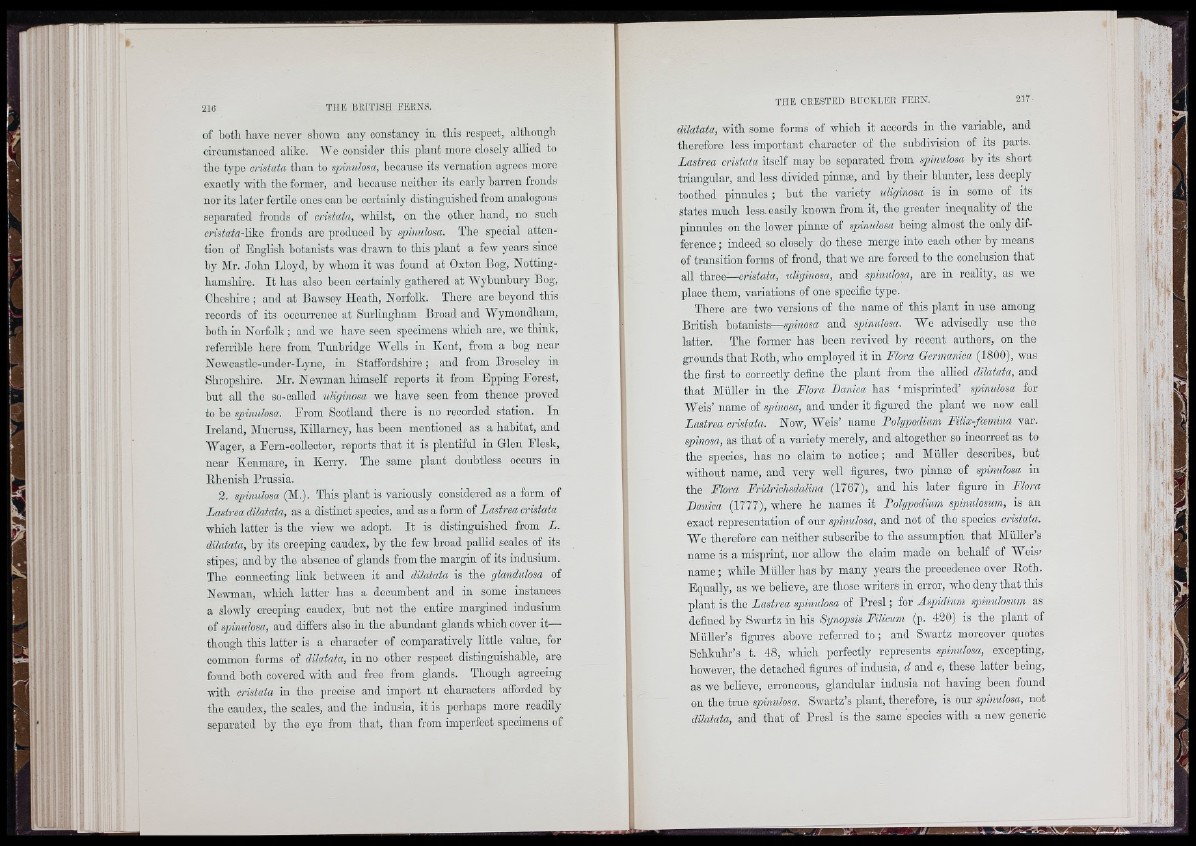
of both havo never shown any constancy in this respoot, although
circumstanced alike. IVc consider this plant more closely allied to
the typo cristata than to spinulosa, because its vernation agrees moro
exactly with tho former, and because neither its early barren fronds
nor its later fertile ones can he certainly distinguished from analogous
separated fronds of cristata, whilst, on tho other hand, no such
c/’isteto-lilvo fronds are produced hy spinulosa. Tho special attention
of English botanists was drawn to this plant a few years sinoo
hy Mr. John Lloyd, by whom it was found at Oxton Bog, Nottinghamshire.
I t has also been certainly gathered at Wyhuiihury Bog,
Cheshire ; and at Bawsey Heath, Norfolk. There are beyond this
records of its ocourrenoe at Surlingham Broad and 'VVymoiidham,
both ill Norfolk ; and we have seen specimens which are, we think,
referrible here from Tunbridge Wells in Kent, from a hog near
Neweastlo-uiider-Lyno, in Staffordshire; and from Brosoley iu
Shropshire. Mr. Newman himself reports it from Epping Forest,
but all tho so-called uliginosa we have seen from thence proved
to be spinulosa. From Scotland there is no recorded station. In
Ireland, Mucruss, Killarney, has been mentioned as a habitat, and
Wager, a Fern-colleotor, reports th a t it is plentiful in Glen Flesk,
near Kenmare, in Kerry. The same plant doubtless occurs in
Rhenish Prussia.
2. spinulosa (M.). This plant is variously considered as a form of
Lastrea dilatata, as a distinct species, and as a form of Lastrea cristata
which latter is the view we adopt. I t is distinguished from L.
dilatata, by its creeping caudex, by the few broad palhd scales of its
stipes; and hy tho absence of glands from the margin of its indusium.
The connecting link between it and dilatata is the glandulosa of
Newman, which latter has a decumbent and in some instances
a slowly creeping candex, hut not the entire margined indusium
of spinulosa, and differs also in the abundant glands which cover it—
though this latter is a character of comparatively little value, for
common forms of dilatata, in no other respect distinguishable, are
found both covered with and free from glands. Though agreeing
with cristata in the precise and import nt characters afforded by
the candex, the scales, and the indusia, it is perhaps more readily
separated by the eye from that, than from imperfect specimens of
dilatata, with some forms of which it accords in the variable, and
therefore less important character of the subdivision of its parts.
Lastrea cristata itself may be separated from spinulosa by its short
triangular, and less divided pinnæ, and by their blunter, less deeply
toothed pinnules ; but the variety uliginosa is iu some of its
states much less, easily known from it, the greater incquahty of the
pinnules on the lower pinnæ of spinulosa being almost the only difference
; indeed so closely do these merge into each other hy means
of transition forms of frond, th a t we are forced to tho conclusion that
all three—cristata, tiliginosa, and spinulosa, aro in reality, as we
place them, variations of one specific type.
There aro two versions of the name of this plant in use among
British botanists—spínosíi and spinulosa. We advisedly use tho
latter. The former has been revived hy recent authors, on the
grounds that Roth, who employed it in Flora Germánica (1800), was
the first to correctly define tho plant from the allied dilatata, and
that Miiller in the Flora Danica has ‘misprinted’ spinulosa for
Weis’ name of sjnnosa, and under it figured the plant we now caU
Lastrea cristata. Now, Weis’ name Polypodium Filix-fcernina var.
spinosa, as th a t of a variety merely, and altogether so incorrect as to
the species, has no claim to notice ; and Muller describes, but
rvithout name, and very well figures, two pinnæ of spinulosa in
the Flora Fridrichsdalimt (1767), and his later figure in Flora
Danica (1777), whore he names it Dolypodium spinulosum, is an
exact representation of our spinulosa, and not of the species cristata.
We therefore can neither subscribe to the assumption that Miillor’s
name is a misprint, nor allow the claim made on behalf of Weis>
name ; whde Muller has by many years the precedence over Roth.
Equally, as we believe, are those writers in error, who deny that this
plant is the Lastrea spinulosa of Presl ; for Aspidium spinulosum as
defined by Swartz in his Synopsis Filicum (p. 420) is the plant of
Muller’s figures above referred to ; and Swartz moreover quotes
Schkuhr’s t. 48, which perfectly represents spinulosa, excepting,
however, the detached figures of indusia, d and e, these latter being,
as we believe, erroneous, glandular mdusia not having boon found
on the true spinulosa. Swartz’s plant, therefore, is our spinulosa, not
dilatata, and th a t of Presl is the same species with a new generic
B